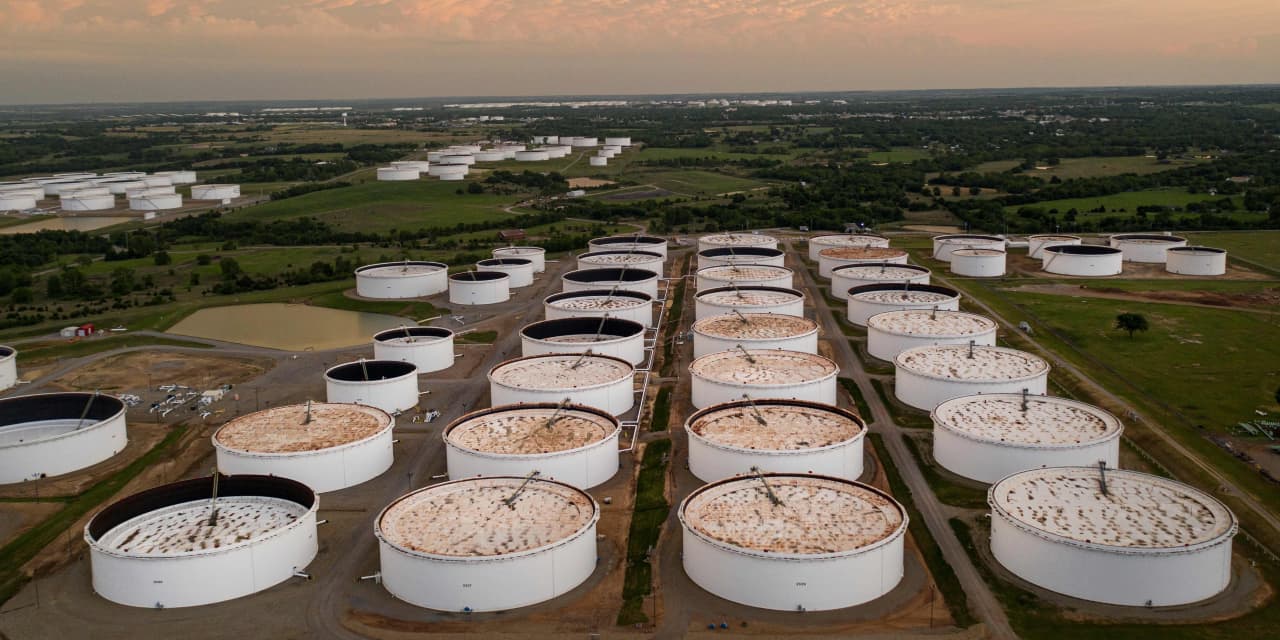Oil futures finished higher on Thursday as traders weighed the outlook for demand, as well as risks to supply caused by strife in the Middle East.
Prices climbed toward session highs after the Energy Information Administration reported an unexpected weekly decline in U.S. commercial-crude supplies, along with increases in petroleum-product inventories.
Price moves
-
West Texas Intermediate crude for February delivery
CL00,
+0.28% CL.1,
+0.28% CLG24
climbed by $1.52, or 2.1%, to settle at $74.08 a barrel on the New York Mercantile Exchange. -
March Brent crude
BRN00,
+0.08% BRNH24,
+0.17% ,
the global benchmark, added $1.22, or 1.6%, at $79.10 a barrel on ICE Futures Europe. -
February gasoline
RBG24,
+0.07%
rose nearly 2.3% to $2.18 a gallon, while February heating oil
HOG24,
+0.99%
tacked on 1.5% to $2.69 a gallon. -
Natural gas for February delivery
NGG24,
+0.26%
settled at $2.70 per million British thermal units, down 6%.
Demand and Middle East risks
The Paris-based International Energy Agency on Thursday projected that growth in oil demand will ease to 1.2 million barrels a day in 2024 from 2.3 million barrels a day last year, taking total demand to an average of 103 million barrels a day. Demand growth for 2024 was previously estimated at 1.1 million barrels a day.
The IEA forecast “aligns with the Organization of the Petroleum Producing Countries’ (OPEC) stable demand-growth expectations, though the cartel forecasts a dramatically stronger growth in demand” this year, said Matthew Weller, global head of research at FOREX.com and City Index, in market commentary.
On Wednesday, OPEC forecast in a monthly report that global oil demand will grow by 2.2 million barrels per day this year, unchanged from its previous projection.
Oil traders have largely looked past the threat of a wider Middle East conflict, even as attacks on Red Sea shipping vessels by Yemen-based Houthi militants, who are backed by Iran, have forced the rerouting of tankers and cargo ships.
“The tensions in the Middle East, while still elevated, have not yet caused any meaningful disruptions to supply, and concerns about the regional conflict are easing with time,” analysts at Sevens Report Research wrote in Thursday’s newsletter.
Pakistan’s air force launched retaliatory airstrikes early Thursday on Iran allegedly targeting militant positions, an attack that killed at least seven people and further raised tensions between the neighboring nations. The strikes followed Iran’s attack Tuesday on Pakistani soil that killed two children in the southwestern Balochistan province.
With tensions in the Red Sea on the rise, it “may only be a matter of time before a situation where Iran gets involved,” said Tariq Zahir, managing member at Tyche Capital Advisors, in emailed commentary to MarketWatch. And if Iran disrupts trading through the Strait of Hormuz, a critical oil-transit chokepoint, oil prices “could go substantially higher,” he said.
Supply data
Meanwhile, the EIA on Thursday reported that U.S. commercial-crude inventories fell by 2.5 million barrels for the week ended Jan. 12. The data came out a day later than usual due to Monday’s Martin Luther King Jr. holiday.
On average, analysts surveyed by S&P Global Commodity Insights forecast a weekly increase of 93,000 barrels. Late Wednesday, the American Petroleum Institute reported an inventory gain of 483,000 barrels, according to a source who cited the figures.
The EIA report also revealed supply increases of 3.1 million barrels for gasoline and 2.4 million barrels for distillates. The S&P Global Commodity Insights analyst survey showed forecasts for gains of 3.6 million barrels for gasoline and 1.9 million barrels for distillates.
Crude stocks at the Cushing, Okla., Nymex delivery hub fell by 2.1 million barrels last week, the EIA said, while U.S. oil production rose by 100,000 barrels to 13.3 million barrels a day. That matched the record weekly production reported by the EIA for the weeks ended Dec. 15 and Dec. 22.
Read: The U.S. is breaking oil-production records with fewer drilling rigs. Here’s how.
Separately, the EIA also reported Thursday that U.S. natural-gas supplies in storage fell by 154 billion cubic feet for the week ended Jan. 12, though remained 320 bcf above the five-year average. Schneider Electric had forecast a withdrawal of 170 bcf.
—The Associated Press contributed.
Read the full article here







